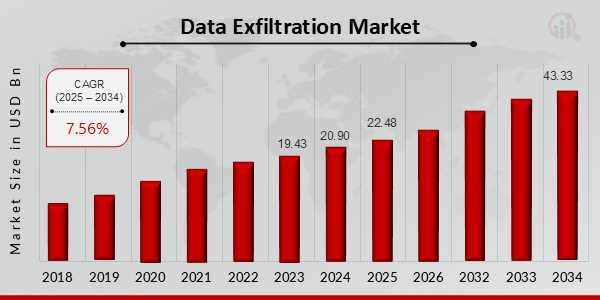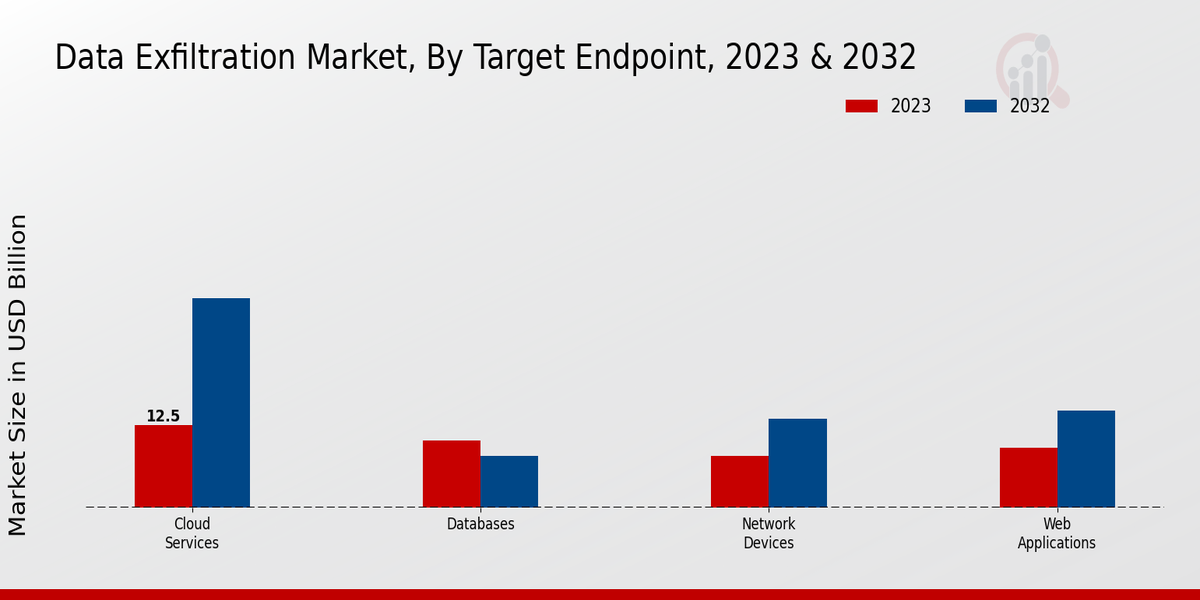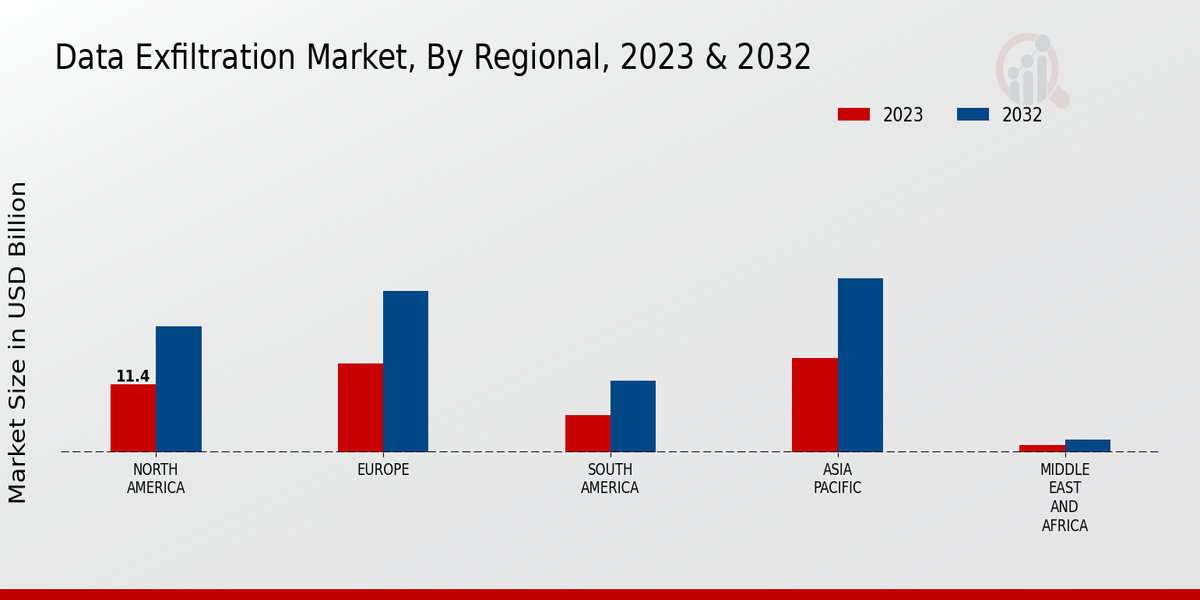Data Exfiltration Market Overview
Data Exfiltration Market is projected to grow from USD 22.48 Billion in 2025 to USD 43.33 Billion by 2034, exhibiting a compound annual growth rate (CAGR) of 7.56% during the forecast period (2025 - 2034). Additionally, the market size for Data Exfiltration Market was valued at USD 20.90 billion in 2024.
Key Data Exfiltration Market Trends Highlighted
The increasing adoption of cloud computing and the growing volume of sensitive data stored online are major drivers of the data exfiltration market. Organizations are increasingly recognizing the need to protect their data from unauthorized access and data breaches, leading to a surge in demand for data exfiltration prevention solutions. The growing sophistication of cyberattacks and the rise of ransomware are also contributing to the market's growth, as organizations seek advanced security measures to safeguard their data.
Key trends in the data exfiltration market include the increasing adoption of artificial intelligence (AI) and machine learning (ML) for threat detection and prevention. Cloud-based data exfiltration prevention solutions are gaining popularity due to their scalability and cost-effectiveness. The market is also witnessing growing demand for managed security services, as organizations seek expertise in implementing and managing data exfiltration prevention solutions.
Opportunities in the data exfiltration market include the development of innovative security technologies, such as blockchain and quantum computing. The growing awareness of data privacy regulations and the need to comply with industry standards is also creating opportunities for market growth. Additionally, the increasing adoption of internet of things (IoT) devices and the expansion of the remote workforce are expected to drive the market's growth in the coming years.
Figure 1 Data Exfiltration Market Overview (2025-2034)

Source: Primary Research, Secondary Research, MRFR Database and Analyst Review
Data Exfiltration Market Drivers
Increasing Prevalence of Cyberattacks
The number of cyberattacks is increasing every year, and they are becoming more and more complex. Data exfiltration is a significant issue for businesses of all sizes. In 2023, there were 39.1 billion global cyberattacks. It is predicted to rise to 183 billion by the end of 2032. As the number of cyberattacks increases, the risk of data exfiltration also rises. Businesses should recognize this risk and take action to prevent their data from being stolen.
Growing Adoption of Cloud Computing
The growing adoption of cloud computing is facilitating the growth of the data exfiltration market. Thus, many businesses rely on the cloud to store their private data even though this can increase their vulnerability to attacks. In 2023, the global cloud computing market was valued at USD 480.94 billion. However, this figure is expected to grow to USD 1,554.92 billion by 2032. As a result, more businesses are likely to expand their data storage through the cloud, leading to a rise in demand for data exfiltration solutions.
Increasing Regulatory Compliance
With an increase in the number of regulatory requirements. Governments continue to put in place regulations that require businesses to protect their data from being stolen. For instance, General Data Protection Regulation in the European Union requires businesses to adequately protect the personal data of their customers. As a result, the demand for data exfiltration solutions is on the rise as businesses are expected to comply with these regulations.
Data Exfiltration Market Segment Insights
Data Exfiltration Market Target Endpoint Insights
The Data Exfiltration Market is segmented into various target endpoints, including cloud services, databases, network devices, web applications, and other endpoint types. Each segment exhibits unique characteristics and growth dynamics, contributing to the overall market landscape.
Cloud services have emerged as a prominent target for data exfiltration, with the increasing adoption of cloud-based infrastructure and applications. The growing volume of sensitive data stored and processed in the cloud has made it an attractive target for malicious actors seeking to steal and exploit valuable information. The revenue from cloud services is projected to reach $12.5 billion by 2024, exhibiting a significant compound annual growth rate (CAGR).
Databases are another critical target endpoint for data exfiltration, containing sensitive information such as customer records, financial data, and intellectual property. The rise in sophisticated cyberattacks and the increasing value of data have made databases a prime target for data breaches. The segment is expected to grow at a CAGR of 8.2% from 2023 to 2032, reaching a valuation of $10.2 billion by 2032.
Network devices, such as routers and switches, serve as gateways to corporate networks and can be exploited by attackers to gain unauthorized access and exfiltrate data. The increasing number of connected devices and the growing sophistication of cyberattacks have made network devices vulnerable targets. The network device segment is anticipated to grow steadily, reaching a market value of $7.8 billion by 2024.
Web applications, including e-commerce platforms, social media websites, and online banking portals, often handle sensitive user data and financial information. The proliferation of web applications has made them attractive targets for data exfiltration attacks. The analysis suggests that the web application segment is expected to witness robust growth, with a projected market size of $9.1 billion by 2024.
Other endpoint types, such as IoT devices, mobile devices, and industrial control systems, are also potential targets for data exfiltration. The growing adoption of IoT devices and the increasing connectivity of industrial systems have expanded the attack surface for data exfiltration. The other endpoint types segment will contribute significantly to the overall market growth, reaching a valuation of $5.2 billion by 2024.
In summary, the Data Exfiltration Market segmentation provides insights into the specific target endpoints that are vulnerable to data exfiltration attacks. Each segment exhibits unique growth dynamics and challenges, influencing the overall market landscape and driving the demand for data exfiltration prevention solutions.
Figure 2 Data Exfiltration Market By target Endpoint (2023-2032)

Source: Primary Research, Secondary Research, MRFR Database and Analyst Review
Data Exfiltration Market Data Type Insights
The market is segmented by data type into personal identifiable information (PII), financial data, trade secrets, intellectual property, and other data types. Among these segments, the PII recording segment held the largest market share in 2023, accounting for about 40% of the global market revenue. This dominance of the segment is associated with the increased frequency of data breaches and cyberattacks, which target personal data such as names, addresses, phone numbers, and email addresses. Financial data is another key segment, with a market share of around 30% in 2023. With the growing dependence on digital banking and online financial transactions, the financial data segment will remain a target for cybercriminals.
Trade secrets and intellectual property are also key data types, which are valuable targets for data exfiltration because they allow competitors to gain a substantial advantage. Finally, the other data types segment includes many different data types, such as medical records, legal documents, and corporate secrets.The rate of growth of the market for data exfiltration of these other data types is expected to be substantial because of the increasing adoption of cloud computing and the growing number of connected devices.
Data Exfiltration Market Exfiltration Method Insights
The Data Exfiltration Market segmentation by exfiltration method offers insights into the techniques used by malicious actors to extract sensitive data from compromised systems. Among these methods, email attachments remain a prevalent channel, accounting for a significant portion of data breaches.File transfer protocols (FTP) and cloud storage services are also commonly exploited, providing ample opportunities for unauthorized data transfer.
Social media platforms, often overlooked as exfiltration channels, have emerged as a growing threat due to their widespread usage and potential for data leakage.Other exfiltration methods, such as USB drives and physical data transfer, still pose risks and require robust security measures. Understanding the specific exfiltration methods employed by threat actors is crucial for organizations to develop effective countermeasures and protect their sensitive data.
Data Exfiltration Market Vertical Insights
The Data Exfiltration Market is segmented based on industry vertical into healthcare, finance, retail, manufacturing, and other industry verticals. The healthcare industry dheld the largest market share in 2023, accounting for 25.3% of the market revenue. This dominance can be attributed to the increasing adoption of digital health records and the growing number of connected medical devices, making the healthcare sector a prime target for data exfiltration attacks.
The finance industry vertical is expected to witness significant growth over the forecast period, owing to the rising number of online financial transactions and the increasing sophistication of cyber threats targeting financial institutions. In 2024, the finance industry vertical is projected to account for 20.1% of the Data Exfiltration Market revenue.
Data Exfiltration Market Organization Size Insights
The Data Exfiltration Market segmentation by organization size comprises small and medium-sized enterprises (SMEs), large enterprises, and government and public sector organizations. Large enterprises are projected to hold a significant market share in 2023, owing to their increased susceptibility to cyberattacks and the presence of sensitive data that makes them primary targets for data exfiltration.
SMEs, on the other hand, are expected to witness a higher growth rate during the forecast period due to the rising adoption of digital technologies and the increasing number of cyberattacks targeting them. Government and public sector organizations are also anticipated to contribute to market growth as they hold vast amounts of sensitive data and are increasingly becoming targets of cyberattacks.
Data Exfiltration Market Regional Insights
The regional segmentation offers valuable insights into market growth and dynamics. North America is projected to dominate the market with a significant share owing to the presence of well-established technological infrastructure and stringent data protection regulations. Europe is expected to witness steady growth due to government initiatives and investments in cybersecurity measures. APAC is emerging as a lucrative market with increasing adoption of cloud-based services and digital transformation.
South America and MEA are expected to contribute a notable share to the overall market growth, driven by rising awareness about data privacy and government regulations. The Data Exfiltration Market segmentation provides comprehensive data and analysis on market size, growth rate, and regional trends, enabling stakeholders to make informed decisions and identify opportunities for growth.
Figure 3 Data Exfiltration Market By Regional (2023-2032)

Source: Primary Research, Secondary Research, MRFR Database and Analyst Review
Data Exfiltration Market Key Players and Competitive Insights
Major players in the data exfiltration market are constantly striving to gain a competitive advantage by developing innovative solutions, expanding their product portfolios, and forming strategic partnerships. Leading players are investing heavily in research and development to enhance the capabilities of their products and stay ahead of the competition. The data exfiltration market is expected to witness significant growth in the coming years, driven by increasing demand for data protection and compliance solutions. Key players are focusing on expanding their global presence and establishing partnerships with local companies to cater to the diverse needs of customers worldwide. The landscape is characterized by intense competition, with established players and emerging startups vying for market share.
A leading player in the data exfiltration market is Fortinet. The company offers a comprehensive suite of data security solutions, including firewalls, intrusion detection systems, and anti-malware software. Fortinet has a strong global presence and serves a diverse customer base, ranging from small businesses to large enterprises. The company's focus on innovation and customer satisfaction has enabled it to maintain a leading position in the market. Fortinet has been recognized by industry analysts for its exceptional performance and commitment to data security.
Another player is Check Point Software Technologies. The company provides a range of security solutions, including network security, cloud security, and endpoint security. Check Point Software Technologies has a strong presence in the enterprise market and is known for its high-performance security products. The company has also been recognized for its innovation and leadership in the security industry. Check Point Software Technologies is committed to providing customers with the best possible protection against data exfiltration and other security threats.
Key Companies in the Data Exfiltration Market Include
Data Exfiltration Market Developments
The data exfiltration market is projected to grow from USD 18.07 billion in 2023 to USD 34.8 billion by 2032, at a CAGR of 7.56% during the forecast period. Increased adoption of cloud computing and the proliferation of connected devices are key factors driving the growth of the market. However, stringent government regulations and data privacy concerns may hinder market growth.Major players in the data exfiltration market include IBM, Symantec, McAfee, and Cisco. These players offer a range of data exfiltration prevention solutions, including data loss prevention (DLP) tools, network security firewalls, and intrusion detection and prevention systems (IDPS).
The market is expected to witness significant growth in the coming years due to the increasing adoption of cloud-based services and the growing number of connected devices. The proliferation of mobile devices and the rise of the Internet of Things (IoT) are also contributing to the growth of the market. The Asia-Pacific region is expected to be the fastest-growing region in the data exfiltration market. The growth in this region is attributed to the increasing adoption of cloud-based services and the growing number of connected devices. The increasing number of cyberattacks in the region is also contributing to the growth of the market.
Data Exfiltration Market Segmentation Insights
Data Exfiltration Market Target Endpoint Outlook
- Cloud Services
- Databases
- Network Devices
- Web Applications
- Other Endpoint Types
Data Exfiltration Market Data Type Outlook
- Personal Identifiable Information (PII)
- Financial Data
- Trade Secrets
- Intellectual Property
- Other Data Types
Data Exfiltration Market Exfiltration Method Outlook
- Email Attachments
- File Transfer Protocols (FTP)
- Cloud Storage Services
- Social Media Platforms
- Other Exfiltration Methods
Data Exfiltration Market Vertical Outlook
- Healthcare
- Finance
- Retail
- Manufacturing
- Other Industry Verticals
Data Exfiltration Market Organization Size Outlook
- Small and Medium-sized Enterprises (SMEs)
- Large Enterprises
- Government and Public Sector Organizations
Data Exfiltration Market Regional Outlook
- North America
- Europe
- South America
- Asia Pacific
- Middle East and Africa
Data Exfiltration Market Report Scope
|
Report Attribute/Metric
|
Details
|
|
Market Size 2024
|
20.90 (USD Billion)
|
|
Market Size 2025
|
22.48 (USD Billion)
|
|
Market Size 2034
|
43.33 (USD Billion)
|
|
Compound Annual Growth Rate (CAGR)
|
7.56% (2025 - 2034)
|
|
Report Coverage
|
Revenue Forecast, Competitive Landscape, Growth Factors, and Trends
|
|
Base Year
|
2024
|
|
Market Forecast Period
|
2025 - 2034
|
|
Historical Data
|
2019 - 2023
|
|
Market Forecast Units
|
USD Billion
|
|
Key Companies Profiled
|
Splunk, FireEye, Proofpoint, Varonis, Zscaler, CrowdStrike Holdings, Digital Guardian, Mimecast, Rapid7, Mandiant, Palo Alto Networks, Alert Logic, Exabeam, Forcepoint, Microsoft
|
|
Segments Covered
|
Target Endpoint, Data Type, Exfiltration Method, Industry Vertical, Organization Size, Region
|
|
Key Market Opportunities
|
1. Increased remote work 2. Cloud adoption 3. AI-powered data protection 4. Growing adoption in healthcare 5. Government regulations
|
|
Key Market Dynamics
|
1. Increased cloud adoption 2. Rising demand for data protection 3. Growing adoption of IoT devices 4. Advanced persistent threats 5. Stringent government regulations
|
|
Countries Covered
|
North America, Europe, APAC, South America, MEA
|
Frequently Asked Questions (FAQ) :
The Data Exfiltration Market reached a valuation of 20.90 billion USD in 2024.
The Data Exfiltration Market is projected to grow at a CAGR of 7.56% from 2025 to 2034.
The Data Exfiltration Market is anticipated to reach a valuation of 43.33 billion USD by 2034.
North America is expected to hold the largest market share in the data exfiltration market during the forecast period.
The BFSI sector is expected to drive the growth, owing to the increasing adoption of digital technologies and the need to protect sensitive financial data.
Key competitors include IBM, Symantec, McAfee, Trend Micro, and FireEye.
Increasing adoption of cloud computing, the growing threat of cyberattacks, and the increasing regulatory compliance requirements are some major trends influencing the Data Exfiltration Market.
The COVID-19 pandemic has accelerated the adoption of remote work, which has led to an increase in the demand for data exfiltration solutions.
Lack of awareness about data exfiltration threats, the shortage of skilled cybersecurity professionals, and the increasing sophistication of cyberattacks are some of the key challenges faced by the market.
The increasing adoption of cloud computing, the growing awareness about data exfiltration threats, and the increasing regulatory compliance requirements are some key opportunities for growth.

















